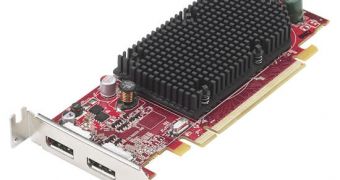Chip manufacturer Advanced Micro Devices released a new graphics card in the FireMV series, targeted at the workstations graphics market. The FireMV 2260 is a half-height, low-profile video card that will arrive on the market in multiple slot flavors, such as PCI, PCIe x1, or PCIe x16 configurations.
The new graphics card offering from AMD comes with 256MB of RAM and natively supports the dual Display Port technology. The new digital interface may not be as widely spread as the HDMI interface, let alone the standard DVD connector, and that is why the manufacturer is bundling DisplayPort to DVI adapters with the card.
The FireMV 2260 card can drive displays running at resolutions of up to 1900x1200 for the DVI interface or up to 2560x1600 via the DisplayPort interconnect. The discrepancy consists in the maximum bandwidth rate each standard can deliver.
AMD's new workstation graphics card is especially tailored for financial institutions, where it would "increase trader density", due to its passive cooling system. The card merely incorporates a passive heatsink, because its energy-efficiency dramatically reduces the amount of dissipated heat.
When compared to the desktop and notebook graphics market, the workstation segment is extremely limited. However, AMD and Nvidia have been competing here for quite some time now, and both players managed to push their high-end 2D tuned graphics cards for more than $2000 per unit. However, the workstation graphics market remained under Nvidia's domination, that now enjoys a market share of about 86 percent.
According to market analysis company iSuppli the workstation graphics cards shipments climbed from 686,700 units in Q4 2006 to 847,900 in the same period last year, which means that the yearly growth rate was more than 23 percent. Surprisingly enough, the generic PC graphics market came in at about 14.1 percent.
The card will be able to render 2D and 3D video feeds and will also work with Windows Vista's Aero interface. The card will start shipping in early April for an estimative retail price of $250.

 14 DAY TRIAL //
14 DAY TRIAL //